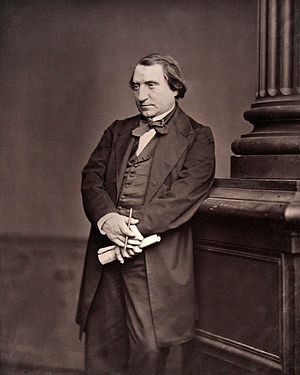Toleration facts for kids
Toleration is when one allows or permits an action, idea, object, or person that one dislikes or disagrees with. The opposite of tolerance is intolerance.
Historian Alexandra Walsham notes that the modern understanding of the word "toleration" may be very different from its historic meaning. Toleration in modern parlance has been analyzed as a component of a liberal or libertarian view of human rights.
John Gray states that "When we tolerate a practice, a belief or a character trait, we let something be that we judge to be undesirable, false, or at least inferior; our toleration expresses the conviction that, despite its badness, the object of toleration should be left alone."
Intolerance is often found in dictatorships historically and often causes the hate crime and hate speech. Tolerance is often about religion (religious toleration), political opinion, nation, race, disability or gender identity.
History
In "On Liberty" (1859) John Stuart Mill concludes that opinions ought never to be suppressed, stating, "Such prejudice, or oversight, when it [i.e. false belief] occurs, is altogether an evil."
In his 1882 essay "What is a Nation?", French historian and philosopher Ernest Renan proposed a definition of nationhood based on "a spiritual principle" involving shared memories rather than a common religious, racial, or linguistic heritage. Thus members of any religious group could participate fully in the nation's life. "You can be French, English, German, yet Catholic, Protestant, Jewish, or practicing no religion."
In 1948, the United Nations General Assembly adopted Article 18 of the Universal Declaration of Human Rights, which states:
Everyone has the right to freedom of thought, conscience, and religion; this right includes freedom to change his religion or belief and freedom, either alone or in community with others and in public or private, to manifest his religion or belief in teaching, practice, worship, and observance.
Though not formally legally binding, the Declaration has been adopted in or has influenced many national constitutions since 1948. It also serves as the foundation for a growing number of international treaties and national laws and international, regional, national, and sub-national institutions protecting and promoting human rights, including the freedom of religion.
Modern analyses and critiques
Contemporary commentators have highlighted situations in which toleration conflicts with widely held moral standards, national law, the principles of national identity, or other strongly held goals. The French head scarf controversy represents a conflict between religious practice and the French secular ideal. Toleration of or intolerance toward the Romani people in European countries is a continuing issue.
Images for kids
-
Sculpture Für Toleranz ("for tolerance") by Volkmar Kühn, Gera, Germany
-
The cross of the war memorial and the Menorah for Jewish people coexist in Oxford.
-
Minerva as a symbol of enlightened wisdom protects the believers of all religions (Daniel Chodowiecki, 1791)
-
Original act of the Warsaw Confederation 1573. The beginning of religious freedom in the Polish-Lithuanian Commonwealth
-
The Maryland Toleration Act, passed in 1649.
See also
 In Spanish: Tolerancia social para niños
In Spanish: Tolerancia social para niños






